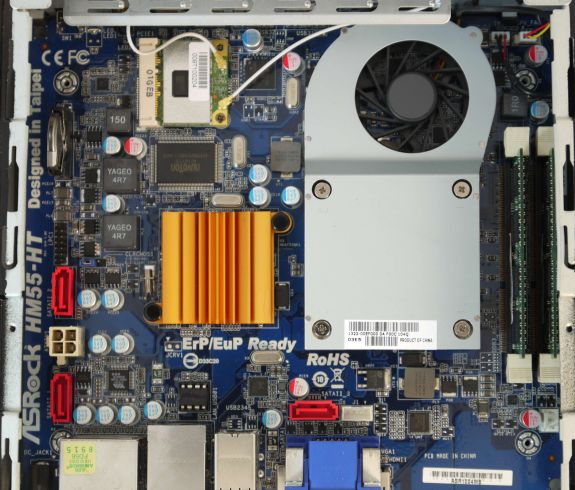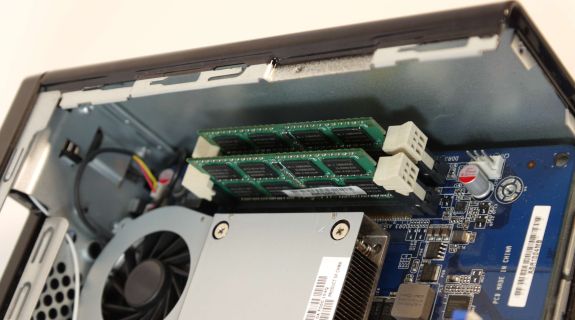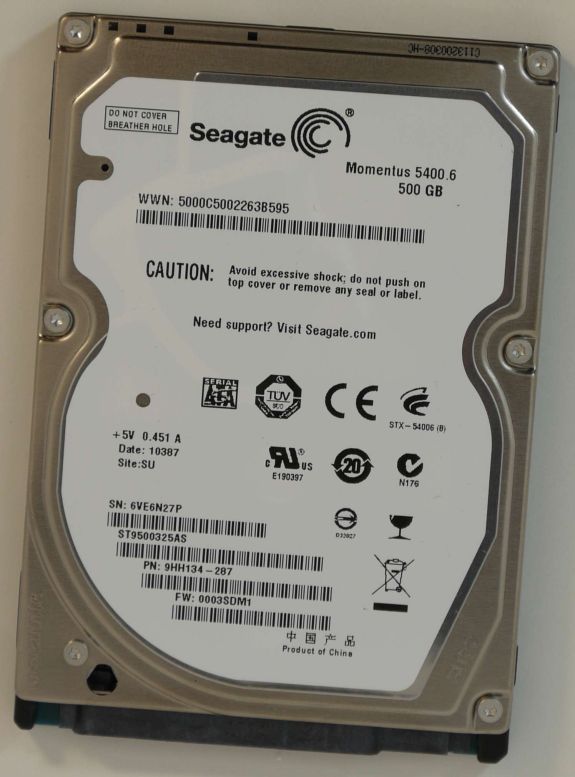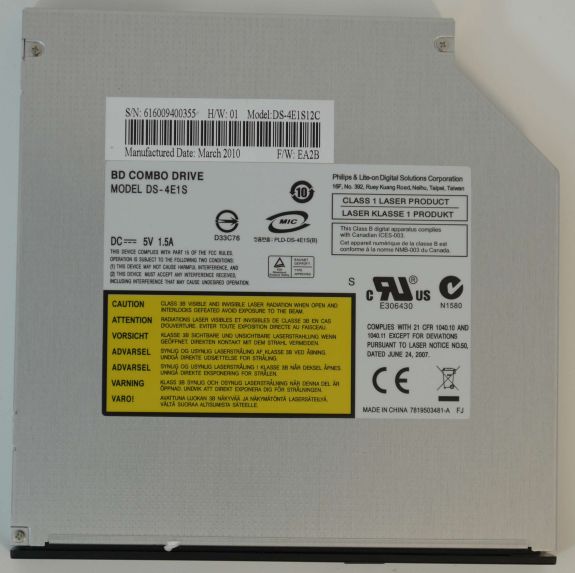ASRock Core 100HT-BD : Bringing HTPCs to the Mainstream Market [UPDATED : Noise Issue]
by Ganesh T S on July 19, 2010 9:34 PM EST- Posted in
- Home Theater
- Arrandale
- ASRock
- Media Streamer
- Core i3
- HTPC
Analyzing the system specifications reveals one clear advantage for ASRock. It is not going to be possible for the average HTPC enthusiast to build a similar system himself with off-the-shelf components. The reason lies in the fact that the Arrandale processor used in the system is currently available for OEM purchase only. All the processors available for general purpose (the Clarkdales) do not fit in the same power envelop as the Arrandales. We covered the Arrandale platform in detail earlier, and concluded that it had a very good power consumption / performance balance. In this section, we will analyze each of the system components in detail.
Motherboard & Chipset: mini-ITX Mobile Intel H55 Express
Over the last 6 months, we have seen many motherboards featuring the H55 chipset. In the mini-ITX form factor, we have covered Zotac's offering as well as Gigabyte's. However, both of them are meant for the desktop Clarkdale processors. What we see in the Core 100 HT-BD is more similar to the motherboards one sees in notebooks. Feature wise, the ASRock motherboard can be compared with the Gigabyte version, since both have support for USB 3.0 ports. However, being a mobile platform, there are some important differences. Tagging on USB 3.0 ports to the HM55 chipset is fraught with issues (more on this in the Performance section). Also, there is no PCI-E x16 slot in the motherboard because the chipset doesn't support it. DVI and PS2 ports are also absent. However, compared to the Gigabyte board, we have two extra USB 2.0 ports. The odd thing to observe here is that ASRock has decided to go with a VGA port instead of DVI, and providing us with a HDMI to DVI adapter, instead of providing a DVI port with a DVI to VGA adapter for folks with older equipment.
Rounding up the other components of the motherboard, we have the Realtek RTL8111E for GbE, and the VIA VT2020 for audio. The mini PCI-E expansion slot is occupied by the Atheros AR9287 module capable of 300 Mbps. As can be seen from the photograph, we have wires connected to the side panels, which act as antennae for the wireless signals. Like many other offerings in the market, ASRock also uses NEC's USB3 controller, giving the system two USB 3.0 ports. Another interesting chip on the board is the Nuvoton NCT6775F. It handles all the sensors (fan speed, temperature etc.) and also the IR support for the MCE remote.
The H55M chipset supports upto 4 SATA ports. In the Core 100 HT-BD, two of them are used by the Blu Ray drive and the hard disk. One of them is free for use by an optional 2nd hard drive (or SSD). The last one is made available as an eSATA port on the back panel. The mini-PCIE slot, as already mentioned, is taken up by the wireless module. In essence, the Core 100-HT BD's motherboard is a notebook motherboard in the mini-ITX form factor.
The Gigabyte mini-ITX (based on the H55) with the USB 3.0 ports can be purchased from Newegg currently for around $100. Since ASRock's version is based on the mobile version of the chipset, and also has a THX certified audio codec chip, the cost is bound to be slightly higher. One must also take into consideration the cost of the Atheros AR9287, which can be bought for around US $15 online. For the purpose of cost analysis, let us assume that one may theoretically be able to purchase a similar motherboard for US $140.
CPU & GPU: Intel Core i3-330M @ 2.13 GHz, iGPU @ 667 MHz
For the form factor and thermal design of the Core 100 HT-BD, only processors with a maximum TDP of 35W are supported. Also, most HTPCs do not require features like Turbo Boost, particularly when their performance exceeds what people have come to expect out of a particular form factor (talking about the Atom nettops) by a magnitude. Keeping in mind the cost of the processors and the nett cost of the system, ASRock has decided to go with the lowest end of the Arrandale spectrum, namely, the Core i3-330M. We feel that this is a very good choice, as the processor is powerful enought for most of today's demanding tasks, particularly from a HTPC perspective.
The integrated GPU is clocked at 600 MHz by default in the system, but it can be easily overclocked to 900 MHz without much effect on fan noise or any concerns about the system heating up. Most HTPC users are more interested in turning down the heat and power consumption. Towards this, attempts are made to undervolt or underclock the CPU. In our opinion, for the Core 100 HT-BD, the savings obtained through these methods are not worth the trouble. Intel's SpeedStep technology is enabled on this system, and we observed that the cores would clock around 940 MHz when doing light browsing tasks, and kick upto 2.14 GHz under heavy load. It is easy to overclock the system too (from within Windows, as well as the BIOS), but the need would probably be never felt in a HTPC usage scenario.
The pricing of the Core i3-330M is available only to OEMs. Our sources, however, informed us that it costs around US $135 in high volume.
DRAM: Elixir Memory's 2 x 2GB Nanya DDR3 @ 1066 MHz
The Core 100 HT-BD has two DDR3 slots, both of which are occupied by the 2 GB Nanya DIMMs. One can potentially use 4 GB DIMMs to get 8GB of system memory, but that would be an overkill from the HTPC perspective. ASRock's choice of 4GB is more than enough for the HTPC.
The 2 DIMMs can be bought currently for around $100 in total from resellers in the US.
Hard Disk: Seagate Momentus 2.5" 5400 rpm 500 GB
Since the form factor of the build indicates that the system is more of a notebook, the hard drive inside is a 2.5" model. ASRock has gone in with the Seagate Momentus 5400 rpm drive. While one might prefer a faster drive for installing the OS, there is no doubt that the lower power consumption of this unit makes it an ideal choice for the HTPC. There is enough space inside the system for an additional 2.5" drive, and filling that up with a SSD would be a great choice for the boot drive. The shipped Seagate drive is ideal and capacious enough for HTPC duties.
The hard drive can be currently had from Newegg for US $65.
Optical Disk Drive: Philips / Lite-On Blu-Ray / DVD RW
The Core 100 HT-BD model ships with the Lite-On DS-4E1S Blu-Ray / DVD RW drive. Again, this is a model meant for notebooks, with the tray not coming out fully when ejected. It can be found online for around $90 without shipping charges taken into consideration.
Miscellaneous Components
The chassis is obviously custom made for this motherboard. ASRock also throws in the SATA, power cables and screws for the optional 2nd hard drive. Mini-ITX cases with PSUs of much higher rating (the unit comes with an external 90W adapter) can be had for around US $50. So, we estimate the cost of the chassis, power adapter and other similar accessories to be around the same. Note that the unit also ships with an IR based MCE remote. Though the build quality of the remote is not high end in nature, we estimate that it adds around $30 to the cost.
Cost Analysis
| ASRock Core 100HT-BD Pricing Analysis | ||||
| Component | Average Price Online | |||
| Motherboard (with mini-PCIe wireless) | $140 | |||
| CPU | $135 | |||
| DRAM | $100 | |||
| HDD | $65 | |||
| Optical Drive | $90 | |||
| MCE Remote & IR Receiver | $30 | |||
| Misc Components (Chassis, Power Adapter, Cables, etc...) | $50 | |||
| Total Cost to Build | $610 | |||
| ASRock Core 100HT-BD Estimated Cost | $700 | |||
Newegg is supposed to have this HTPC for sale soon around the $700 price point. (The model with the DVD drive instead of the Blu-Ray is already on sale for $650.) With only a $90 premium over a home built HTPC, this is not a bad investment from the value viewpoint. Do note that the cost of the OS and keyboard / mouse have to be added on to this to get a sense of the true cost of the system. Also, we still have to take a look at the unit from various other perspectives. Read on to find out more.














107 Comments
View All Comments
Lostclusters - Sunday, July 25, 2010 - link
I know the review mentioned things like "Perfect Blu-Ray playback with bitstreaming", and "able to play back all Blu-Rays with bitstreaming to the AV receiver", but there is no mention of whether the sound is at 24 bits or 16 bits. I am sure that the same limiting factors as any other PC comes into play. But as I am currently not very well informed on Windows 7, I'd like to see some mention of this in the review. Both with LPCM and native codec.ganeshts - Monday, July 26, 2010 - link
Lostclusters,The bitstreaming is perfect. This means whatever bit resolution is present in the soundtrack is passed on as-is, with no downsampling of any sort.
Its HDMI can pass through Dolby True HD and DTS HD Master Audio up to 192KHz/24-bit , whereas absence of passthrough would mean support for only Dolby or DTS 48KHz/16-bit audio quality.
Even on the other sound channel, i.e, VIA VT2020 codec, there exists support for Blu-ray audio up to 7.1ch 192KHz/24-bit audio with content protection.
Lostclusters - Sunday, July 25, 2010 - link
I forgot to mention that this should be examined not only when playing off a Bluray disk but when playing files off the hard drive as well.Lostclusters - Monday, July 26, 2010 - link
Another item not addressed (maybe in the bench marks) is was how it performed an SD media. I know the screen resolution is locked in at 1080. But how well does it play SD media?ganeshts - Monday, July 26, 2010 - link
Lostclusters,While I agree that the majority of the streams in the test suite were HD (after all, that is the future), we do have 5 - 6 SD streams (evident from the file names).
What you may be looking for is the upscaling capabilities of the GPU / software. I didn't pay much attention to this, but things didn't look horribly wrong. So, I would say that it is good enough to play SD media also. I am unable to think of a metric which will give you a quantitative view of the capability.
Lostclusters - Monday, July 26, 2010 - link
Check out this link at the bottom of the post under the heading of "My Pick of HTPC":http://www.avsforum.com/avs-vb/showthread.php?p=18...
LNCPapa - Monday, July 26, 2010 - link
This device really appeals to me - I was seriously considering going with a Mac Mini + Plex but with the price changes I figured I might as well not give Apple any more my money. By the way - great link post LostCluster - That thread was an awesome read and that guy has done an incredible amount of research.If this device had/would launch at a $500 price point I would purchase it now and ask the wife for forgiveness later.
ganeshts - Monday, July 26, 2010 - link
NewEgg seems to have the non-BluRay model for $580 + shipping:http://www.newegg.com/Product/Product.aspx?Item=N8...
Lostclusters - Monday, July 26, 2010 - link
I have been following Rene's work since his first recommendation on hardware. I have even donated to his work. He is one dedicated individual and has several threads on that forum. Many many good threads there. Chocked full of info.Decaff - Tuesday, July 27, 2010 - link
I really enjoyed reading through this article, as I am myself looking for a media streamer solution. I do, however, have some points of inquiry.First of all, the picture quality testing should be figured out. I have seen television review sites who do regular testing of the picture quality. I know that much of this is a often subjective, but I still think it is paramount that this is analysed, as many home theater enthusiasts are highly sensitive to the picture quality. I do think the use of the HQV test is a good starting point, but I still think subjective measures are in order, as a means of relating the numbers to any percieved loss of quality.
In essense, the people investing in HTPC's of media streamers will probably also have a quality TV-set/projector attached to it. So the framerate issue could naturally be a killer for many enthusiasts, as I know this particular issue has been discussed on many TV forums, where they are very concerned with configuring the TV properly to the correct framerate in order to achieve the right picture quality.
Perhaps an alliance with a site that specialises in reviewing picture quality of TV sets?
Secondly, I think you should be more aware of what software you are using on the machine. Naturally, Anandtech is largely a hardware site, but when dealing with a media streamer/HTPC it is essentially the software that defines the final user experience of the setup. Essentially, if I have just bought a HTPC, I don't want to be pestered with 3 different programs in order for the box to do its job. Rather I (and presumably almost everyone else) wants a nice interface that can handle all the tasks the box it built for, preferably using only the remote control, and the occasional keyboard/mouse when performing tasks that are PC-centric.
So my suggestion is to make a large article with HTPC software, where you look at the features it offers, ease of use, and naturally and in relation to my first point, the output quality of them.
Lastly, I'm really looking forward to seeing some reviews of more dedicated (smaller and cheaped) streamer boxes, such as the WDTV live, A.C. Ryan Playon!HD or the Popcorn machines and naturally also a comparison with the gaming consoles as the Playstation 3 or the Xbox 360 and how they fare in comparison, regarding codec support, and of course in the area of picture quality and ease of use.
These last are at the moment those that interest me the most, as I just want a box that can play my movies from an external HDD or a NAS/Home Server, without all the extra stuff (although it is of course nice to have), and I suspect a great deal of people have similar demands and can use another PC to rip their movies.